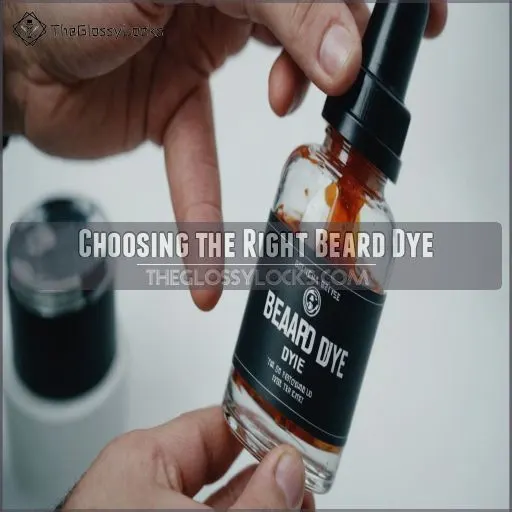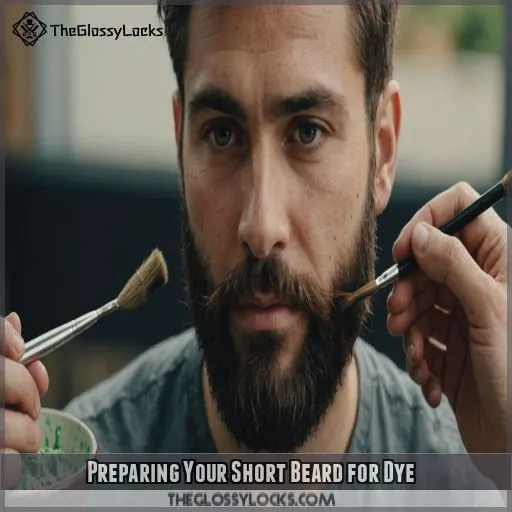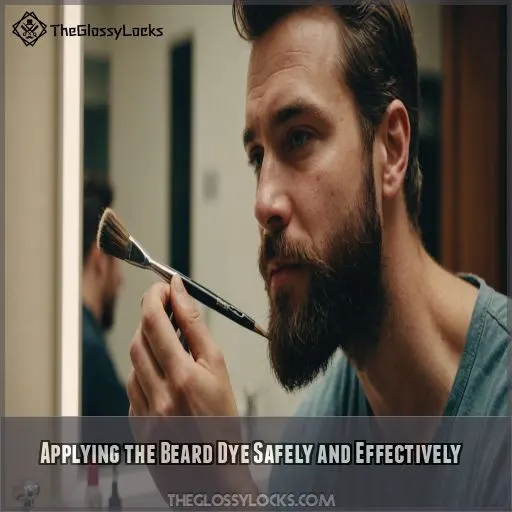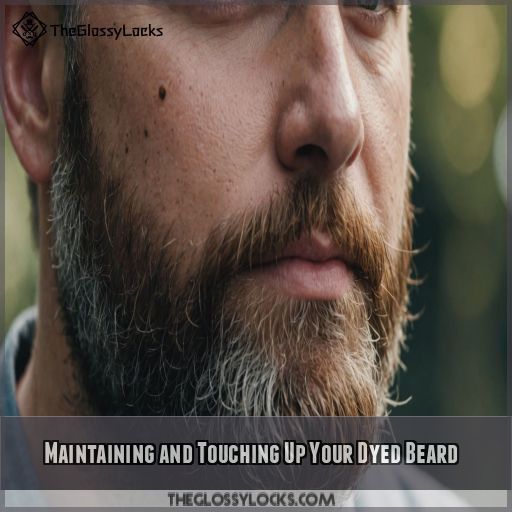This site is supported by our readers. We may earn a commission, at no cost to you, if you purchase through links.
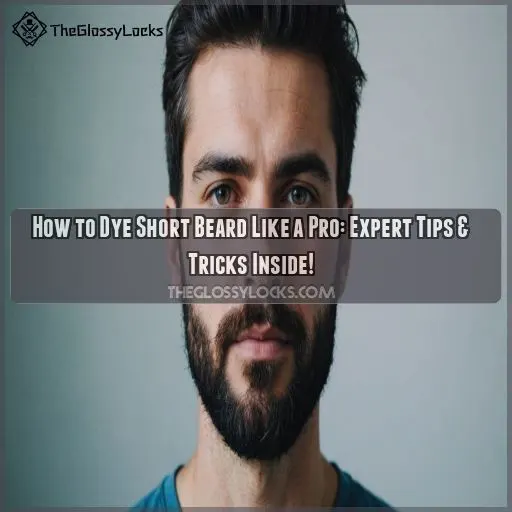 Dyeing to know the secret to a perfectly colored short beard? It all starts with choosing the right dye that complements your skin tone and beard color.
Dyeing to know the secret to a perfectly colored short beard? It all starts with choosing the right dye that complements your skin tone and beard color.
Consider your skin’s undertones – cool skin tones look great with blue or purple undertones, while warm skin tones rock golden or honey undertones.
Next, prep your beard by washing and conditioning it with a gentle, sulfate-free shampoo. Towel-dry, then apply the dye, following the instructions carefully.
And remember, less is more – check the color progress every 5-10 minutes to avoid overprocessing.
Want to learn the expert tips to achieve that salon-fresh look?
Table Of Contents
Key Takeaways
- You’ll want to choose a dye that complements your skin tone and beard color – cool skin tones look great with blue or purple undertones, while warm skin tones look great with golden or honey undertones.
- Prep your beard by washing and conditioning it with a gentle, sulfate-free shampoo, and towel-dry before applying the dye – and remember, less is more, so check the color progress every 5-10 minutes to avoid overprocessing.
- Don’t be afraid to experiment and find what works best for you – after all, it’s all about mastering your unique look – and consider your beard texture and hair type to avoid any unwanted dye reactions.
- To maintain that vibrant color, use color-protecting shampoos and conditioners, trim and shape your beard regularly, and schedule regular dye jobs every 4-6 weeks – and don’t forget to moisturize your beard daily to prevent color fade and dryness.
Choosing the Right Beard Dye
You’re ready to take the plunge and dye your short beard, but before you do, you’ll want to choose the right dye to avoid any disasters. By understanding your skin type and beard color, selecting the perfect shade, and considering semi-permanent and permanent options, you’ll be well on your way to achieving the beard of your dreams.
Understanding Your Skin Type and Beard Color
Your beard is an extension of you, so you should think about your skin type and beard color before dyeing.
If you have a cool skin tone, look for dyes with blue or purple undertones.
For warm skin tones, opt for dyes with golden or honey undertones.
Don’t forget to factor in your beard texture and hair type to avoid any unwanted dye reactions.
Selecting the Perfect Shade for Your Short Beard
Imagine this: you, with a beard that’s the perfect shade to make your skin tone glow.
To get there, consider your hair color, beard shape, and skin tone.
Look for dye brands offering natural shades that complement your features.
Don’t be afraid to experiment and find what works best for you – after all, it’s all about mastering your unique look!
Considering Semi-Permanent and Permanent Dye Options
Now that you’ve picked your perfect shade, it’s time to decide on the type of dye. Semi-permanent dyes offer less commitment and gray coverage, but with less dye longevity. Permanent dyes provide longer-lasting color, but may cause more color fading and skin sensitivity. Weigh the pros and cons, and consider your budget – permanent dyes can be pricier!
Allergy Testing and Sensitivity Considerations
Time for an important step – ensuring you don’t turn lobster-red! Perform a skin patch test 48 hours before dyeing to check for sensitivity. Look out for signs like itching, redness, or swelling. If you react, consider safe alternatives or consult a pro. Always read the ingredient labels carefully, and don’t hesitate to seek advice if you’re unsure.
Preparing Your Short Beard for Dye
You’re just one step away from becoming a beard-dyeing master! Before you break out the dye, get your short beard ready for its transformation by washing, trimming, and moisturizing it – trust us, your beard will thank you.
Washing and Conditioning Your Beard Before Dyeing
Time to get your beard squeaky clean before dyeing. Now that you’ve chosen the perfect dye, let’s prep that beard. Wash and condition your beard with a gentle, sulfate-free shampoo and conditioner. Here are some tips to keep in mind:
-
- Use warm water: to open up those hair follicles.
-
- Massage it in: get that shampoo all up in there.
-
- Rinse thoroughly: no leftover soap scum, please.
-
- Towel-dry: no blow-drying, we don’t want frizz.
Trimming and Shaping Your Beard for Even Color
Now that your beard is squeaky clean, it’s time to get a little trim-happy! Grab your trusty beard trimming tools and shape your beard to achieve an even base for dyeing. Avoid patchy beard dye by defining your beard shape and creating seamless fade lines. This will help you get smooth color blending and a pro-level finish.
Removing Tangles and Knots for Smooth Dye Application
To make sure your beard dye goes on smoothly, grab a trusty beard detangling tool, like a wide-tooth comb or a beard rake. Gently work out those knots and tangles, taking care not to tug too hard. For particularly stubborn tangles, try a detangling spray or conditioner to help ease the process.
Using a Beard Oil or Balm for Moisturizing
Before dyeing, give your short beard some TLC with a beard oil or balm. This moisturizing step helps the dye penetrate evenly and reduces irritation. Opt for a lightweight oil or a nourishing balm, depending on your beard type. Massage a small amount into your beard, focusing on the ends, to keep it soft and healthy-looking.
Applying the Beard Dye Safely and Effectively
Now that your short beard is prepped and ready, it’s time to get down to business and apply that dye – safely and effectively, of course. In this section, you’ll learn how to mix, process, and rinse your way to a fabulous, professional-looking beard color that’ll make you feel like a total boss.
Mixing the Dye and Developer for the Right Consistency
To achieve the perfect dye consistency, combine the dye and developer in the recommended ratio – usually 1:1 or 1:2. Use a mixing technique that’s smooth and gentle, like whipping up a meringue. Be careful not to overmix, as this can lead to uneven color results. Get it just right, and you’ll be on your way to a fabulously dyed beard!
Processing Time and Checking the Color Progress
Now that the dye is applied, it’s time to wait. With the dye working its magic, you’re one step closer to achieving your desired shade. Here are a few things to keep in mind during the processing time:
- Check the color progress every 5-10 minutes to avoid overprocessing.
- Be patient, as the dyeing time may vary depending on your beard’s length and thickness.
- Keep an eye on the color depth to make sure you’re getting the results you want.
Rinsing and Shampooing Your Beard After Dyeing
After dyeing, it’s important to rinse your beard thoroughly to remove excess dye. Typically, you’ll want to rinse with warm water until the water runs clear. Here’s a quick rundown of post-dye care:
| Step | Tips |
|---|---|
| Rinse | Use warm water to remove excess dye |
| Shampoo | Use color-safe products, 2-3 times a week |
| Condition | Hydrate your beard with a moisturizing conditioner |
| Dry | Gently blot, don’t rub, to prevent color fade |
| Follow-up | Trim and shape regularly to maintain color |
Maintaining and Touching Up Your Dyed Beard
Now that you’ve successfully dyed your short beard, it’s time to think about maintenance – after all, you want that fabulous color to last! To keep your beard looking its best, you’ll need to make a few simple adjustments to your daily routine and schedule regular touch-ups.
Using Color-Protecting Shampoos and Conditioners
The sweet taste of victory – your beard is now a stunning shade of awesome! To keep it that way, use color-protecting shampoos and conditioners with color-safe ingredients. Shampoo 2-3 times a week, but condition daily to lock in moisture. This duo will prevent color fade, promote hair health, and keep your beard looking fresh and vibrant.
Trimming and Shaping Your Beard to Maintain the Color
To maintain that vibrant color, you’ll need to keep your beard in shape. Here are some tips:
- Use Beard Trimming tools to tidy up stray hairs and prevent split ends, which can lead to color fade.
- Master shaping techniques to keep your beard growth in check and maintain those sharp edges.
- Trim regularly to prevent uneven color and patchiness.
Scheduling Regular Dye Jobs for Optimal Color
You’ve trimmed and shaped your beard to perfection, now it’s time to keep that color popping. To maintain the best color, schedule regular dye jobs every 4-6 weeks. This frequency prevents color fading and keeps your beard vibrant.
| Dye Longevity | Maintenance Frequency |
|---|---|
| Semi-permanent | Every 2-3 weeks |
| Permanent | Every 4-6 weeks |
| High-maintenance | Every 1-2 weeks |
| Low-maintenance | Every 6-8 weeks |
| Root touch-ups | Every 2-4 weeks |
Common Mistakes and Troubleshooting
Now that you’ve successfully dyed your short beard, it’s time to tackle those pesky mistakes that can make or break your look. In this section, you’ll learn how to troubleshoot common issues like overprocessing, uneven color, allergic reactions, and color fade, so you can keep your beard looking its best.
Overprocessing and Underprocessing the Dye
Don’t let your beard dye job go haywire! Overprocessing can lead to damaged locks and uneven color, while underprocessing leaves you with a lackluster hue.
To avoid this, keep a close eye on the dye time and check the color intensity regularly.
If you do slip up, don’t panic – there are ways to fix mistakes without causing more hair damage.
Dealing With Uneven Color and Patchiness
Whoops, uneven color and patchiness happened! Don’t panic, friend! To fix it, try re-dyeing the patchy areas, but be cautious not to overprocess. Use a tint brush to target the spots, and leave the dye on for a shorter time. For a seamless blend, use a beard oil or balm to moisturize and soften your beard.
Fixing Allergic Reactions and Skin Irritation
Uh-oh, allergy alert! If you notice redness, itching, or irritation after dyeing your beard, don’t panic! Soothe the irritation with natural remedies like aloe vera or tea tree oil. Identify the allergy cause – probably a chemical in the dye – and take steps to prevent future reactions. Aftercare is key: gently wash your beard and apply a calming balm.
Preventing Color Fade and Dryness
Now that we’ve tackled those pesky allergic reactions, let’s keep your newly dyed beard looking fresh! To prevent color fade and dryness, use a hydrating beard oil or balm daily. Invest in color-safe shampoos and conditioners, and avoid hot tools. By doing so, you’ll lock in that vibrant color and keep your beard soft and manageable.
Frequently Asked Questions (FAQs)
How often should I dye my short beard for maintenance?
Picture your beard as a thirsty plant – it needs nourishment, not constant color blasts! Dye your short beard every 4-6 weeks to maintain the color, allowing your natural growth cycle to shine through.
Can I use regular hair dye on my short beard?
You can use regular hair dye on your short beard, but it’s not the best option. It can dry out your beard more than a beard-specific dye and may not provide the desired results (Source).
Will dyeing my short beard cause any skin irritation issues?
Imagine David, who dyed his short beard a deep brown, only to discover an itchy, red rash underneath. To avoid his fate, do a patch test before dyeing, and choose a beard dye with Natural Ingredients.
Can I dye my short beard a significantly lighter color?
Going for a drastic change, eh? Dyeing your short beard a much lighter color can be a bit tricky, but it’s doable! Just remember to choose a dye specifically formulated for facial hair and follow the instructions carefully (Source).
How long does short beard dye typically last on average?
Like a fresh new ‘do, beard dye can fade fast! On average, short beard dye lasts around 4-6 weeks, but with proper care, you can stretch it to 8 weeks – now, that’s what I call ‘dye-namite’ staying power!
Conclusion
You’ve made it to the final stroke of genius – mastering the art of dyeing your short beard!
With these expert tips, you’re now a maestro of color, ready to show off your unique style.

